Subject
- #Madecassoside
- #Beauty
- #Skin Inflammation Management
- #Skin Trouble
- #Cica
Created: 2024-03-13
Created: 2024-03-13 16:15
Madecassoside and cica are both known for their ability to soothe and regenerate the skin, but there are some differences between them.

Madecassoside effective in inflammation reduction
Madecassoside is one of the ingredients that provides many benefits to the skin, particularly in soothing inflammation and protecting the skin. It is primarily used to soothe the skin and is effectively used for various skin types.
One of its main functions is to soothe inflammation. When the skin is irritated or inflamed, Madecassoside helps relieve inflammation and soothe the skin. This is particularly effective in treating inflammation caused by acne or blemishes. It also promotes skin regeneration, helping to quickly restore damaged skin.
Finally, it is also effectively used for dry or sensitive skin. Dry skin is characterized by a lack of moisture, making it prone to dryness and cracking. Using Madecassoside on such skin can protect and moisturize it, maintaining it in a healthy state. Sensitive skin is susceptible to irritation and inflammation, so Madecassoside helps soothe and protect sensitive skin.

Madecassoside benefits and side effects
While Madecassoside is effective in promoting skin regeneration, it can occasionally cause side effects.
If you experience any side effects while using Madecassoside, it is advisable to stop using it immediately and consult a dermatologist or doctor. Side effects can vary depending on individual skin type and sensitivity. Therefore, when using a new product, it is essential to always conduct a patch test and monitor the results.
Comments0